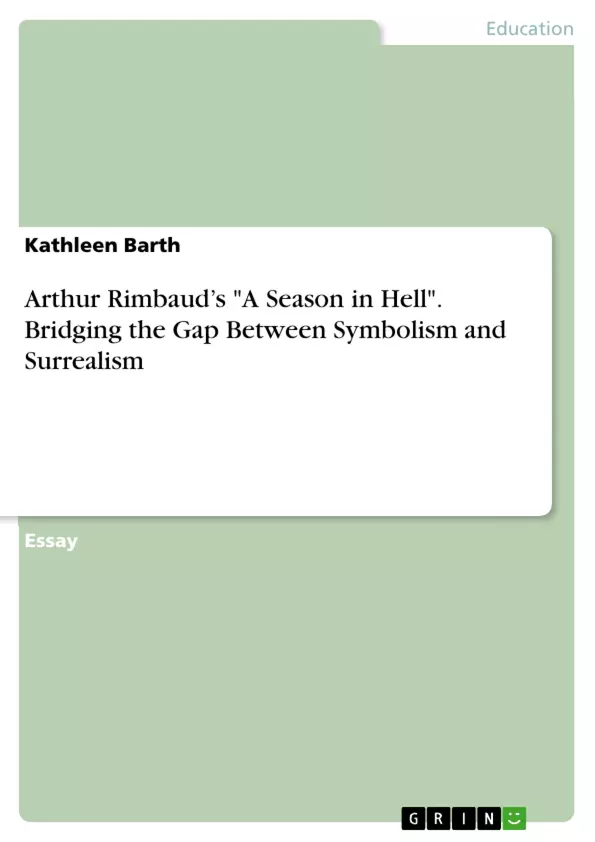A chronicle of the symbolists' influence over Rimbaud's early poetry, and how he laid the foundation for Surrealism with his exploration of the unconscious in "A Season in Hell".
As a young poet, Arthur Rimbaud expressed a keen desire of becoming a seer: one who forecasts the future through supernatural insight. Throughout his career, he sought visionary status by pushing the boundaries of poetic expression with his efforts of materializing the supernatural in his poetry. Rimbaud began fulfilling his goal by studying the work of the symbolists and incorporating their revolutionary modes of expression into his own poetry. Yet Rimbaud pushed the boundaries of poetic expression even further with his efforts to penetrate the deepest layers of the mind.
By 1873, Rimbaud began exploring the mysterious realm of the unconscious through his own method of psychoanalysis, a popular subject of Surrealism: a movement that entered the literary scene nearly four decades after the French Symbolists. Rimbaud portrays his unconscious thoughts and memories in A Season in Hell with the style he adapted from studying the symbolists. By composing A Season in Hell with the stylistic elements of Symbolism and the psychoanalytical focus that dominated Surrealism, Rimbaud bridges the gap between both poetic movements
Inhaltsverzeichnis (Table of Contents)
- Introduction
- Making a Splash
- Anatomy of the Mind
- Rimbaud's Inferno
- Life After Death
Zielsetzung und Themenschwerpunkte (Objectives and Key Themes)
This work explores the evolution of Arthur Rimbaud's poetic expression, tracing his journey from early influences of Symbolism to his later exploration of the unconscious, a key theme in Surrealism. By analyzing Rimbaud's work, the text aims to demonstrate how he bridged the gap between these two influential poetic movements.
- The development of Rimbaud's poetic style
- The influence of Symbolism on Rimbaud's early work
- Rimbaud's exploration of the unconscious
- The connection between Symbolism and Surrealism
- The stylistic elements that define Rimbaud's poetry
Zusammenfassung der Kapitel (Chapter Summaries)
- Introduction: This chapter introduces Arthur Rimbaud's ambition to become a seer and his pursuit of visionary status through his poetry. It highlights his early engagement with Symbolism and his later exploration of the unconscious, which paved the way for his unique contribution to both movements.
- Making a Splash: This chapter examines the origins of Symbolism in the 19th century, focusing on its rejection of Parnassian naturalism and its embrace of indirect expression, symbolism, and free verse. It also analyzes Rimbaud's early poem "The Drunken Boat" as a demonstration of his early engagement with Symbolist principles.
- Anatomy of the Mind: This chapter delves into Rimbaud's exploration of the unconscious, a key theme in Surrealism. It analyzes his use of psychoanalytical techniques in his poetry, particularly in "A Season in Hell," and explores his connection to the Surrealist movement.
- Rimbaud's Inferno: This chapter focuses on Rimbaud's poetic journey through "A Season in Hell," emphasizing his exploration of personal demons, self-destruction, and the dark side of human nature. It examines the stylistic elements that contribute to the poem's intensity and depth.
Schlüsselwörter (Keywords)
This work examines Arthur Rimbaud's poetry, focusing on Symbolism, Surrealism, the unconscious, visionary poetry, poetic expression, stylistic elements, metaphor, imagery, free verse, and "A Season in Hell."
- Quote paper
- Kathleen Barth (Author), 2015, Arthur Rimbaud’s "A Season in Hell". Bridging the Gap Between Symbolism and Surrealism, Munich, GRIN Verlag, https://www.grin.com/document/300722



